Taylor Wilkins Benny Hegbe
Proposal
The social issue we decided to portray in our project is discrimination of immigrants. Discrimination is defined as “prejudiced or prejudicial outlook, action or treatment” according to Merriam Webster dictionary, meaning one is viewed or treated differently based on preconceived values or ideologies. In society today unfortunately, discrimination is such a prevalent issue because there is a myriad of cultures, values, and beliefs in existence. Typically, people form biased opinions and beliefs based on their ignorance of these cultures, values and beliefs. Discrimination perpetuates the racial divide amongst a group of people when in reality people of all races, ages, genders, and backgrounds must come together in order to fight the issues of the world.
According to NPR, those who appear to be immigrants, specifically Hispanic people, report 4 out of 10 have been discriminated against. In another survey, according to NPR 92% of black people say they have been discriminated against. As one can see discrimination is very high in the United States which is why this issue needs to be brought to the attention of others.
In Americanah by Chimamanda Ngozi Adiche the main character, Ifemulu faces discrimination when she visits a black hair salon. Ifemulu visits a hair salon in order to get her hair braided and while at the salon there are numerous snooty comments made by the ladies in the salon even though they are also African, however they ate from a different country. One example being when they ask Ifemulu if she knew a famous Nigerian actress just because they are from the same country. Even after Ifemulu leaves the book states, “They would, she was sure, talk about her after she left … They would laugh with derision, but only a mild derision, because she was still their African sister, even if she had briefly lost her way” (Adiche 126). The women in the salon are clearly treating her different even though technically they are still the same race. Another experience of discrimination in the book was when Emenike, Obinze’s friend, tries to hail a cab in London. He tells the story of a time where the cab driver turns his active light off before passing Emenike and then turns the active light back on after passing him(Adiche 201). In this instance Emenike was pointing out the evident discrimination he had faced from the cab driver due to his ethnicity. Also the book shows another instance of discrimination when Ifemulu and Curt are at the farmer’s market. A black man walks by and mutters how could Curt be with her when it looks as if she’s from the jungle(Adiche 157). All three of these accounts display discrimination on various levels throughout the book.
We decided to choose cinematic virtual reality as our medium to enforce the prevalence of our issue. As we discussed in class our society is becoming less empathetic and virtual reality is a proven tool to help stop this issue. We believe if our audience actually experiences discrimination first hand via a variety of scenes from Americanah, especially those who because of demographic issues may have never or will never experience it, they will be prone to join the fight against discrimination in their daily lives. Virtual Reality is a great way for our audience to become uncomfortable enough to join the fight against discrimination of those who are different from them. Specifically in our VR project we will incorporate three different scenes to display discrimination in different ways. All scenes are adaptations from the book Americanah. We will feature the above described scene where Ifemulu faces discrimination in the hair salon, the scene where Emenike tells the story of the time he couldn’t catch a cab, and when Ifemelu are in the farmer’s market and a man tells her she looks like she’s from the jungle. Our VR experience will be set up that whoever is viewing the story is being discriminated against and it will be as if each story is occurring from their POV.
Script
*Screen starts off black with a quote*
Screen will display: “Discrimination: a prejudiced or prejudicial outlook, action, or treatment” -Meriam Webster
Screen will display: “This is a simulation where you will go through a series of events. By participating in this demonstration you are relinquishing control of your actions and the actions of others.”
Screen will display: “Warning the following content may trigger uncomfortable emotions. If this is a sensitive topic which will evoke uncomfortable memories please proceed with caution”
Scene 1
Screen will display: Adaptation from the book Americanah by Chimamanda Ngozi Adiche. This scene puts a twist on the story told by Emenike. In the book Emenike tried to hail a cab but the driver turns his light off passing by Emenike and the cab driver turns it back on after passing him (Adiche 201).
Screen will display: “We should be open about the fact that issues like these-ones that involve our beliefs about sameness, equality, and difference- are sensitive and can easily arouse our emotions”(“Discrimination: Crash Course Philosophy #41” 0:12-0:21).
*Scene begins with POV person walking out of a residential hall. *
*Uber driver arrives in front of building*
UBER DRIVER: “Are you here for an uber?”
UBER DRIVER: “Um are you from around…here.”
UBER DRIVER: “Cause I dont think…I’ve ever…so where are you from?”
UBER DRIVER: “I haven’t had anyone in my car who looks like you before and I don’t feel safe having you in my car”
UBER DRIVER: “Where’d you say you are from again? I haven’t heard too many good things about your type of people. So I don’t know if I can take you in my car”
UBER DRIVER: “Because I don’t know if you are going to rob me or what. I don’t have time for it, I don’t know where you are from or who you are, your background, and you don’t look like a person– I don’t trust you, I don’t know”
UBER DRIVER: “Yeah I’m going to cancel so good luck getting a ride”
*Uber Driver drives away. Screen goes black*
*Screen displays “People who emigrate to the US following immigration rules and regulations generally are entitled to the same rights and privileges as citizens”(“Discrimination: Crash Course Government and Politics #31” 3:00-3:08).
Scene 2
Screen will display: Adaptation from Americanah by Chimamanda Ngozi Adiche. In the book Ifemulu and Curt are in the farmer’s market. A black man walks by and under his breath says “ever wonder why he likes you looking all jungle like that”(Adiche 157).
*POV is in the grocery store looking for particular food items to purchase. POV goes and taps on grocery worker to ask for help*
GROCERY WORKER: “Hello, do you need help with something”
GROCERY WORKER: “Oh yes it is right this way but can I ask you something? ”
GROCERY WORKER: “You look really unique like your hair and everything…”
GROCERY WORKER: “It looks like straight out of the jungle”
GROCERY WORKER: “where are you from again?”
*screen goes black*
Screen displays: “A survey of conducted by Pew Research Center showed of all adults about 58% believe that race relations in America are generally bad”(Pew Research Center)
Screen displays: “Those who identify as African or African American expressed fewer positive attitudes towards them when told that they face discrimination based on their race rather than their language or immigrant status”(Wiley 1).
Scene 3
Screen will display: Adaptation from Americanah by Chimamanda Ngozi Adiche. This scene puts a twist on when Ifemulu is in the hair salon and the hair stylist insists that Ifemulu knows the Nollywood actors in the movie the salon is watching because she is too from Nigeria (Adiche 78).
RECEPTIONIST: “Hi…where are you from?”
RECEPTIONIST: “I’ve never seen you before…I guess I can check the list and see if you’re on it”
RECEPTIONIST: “Okay I see you, I guess you can go to her”
BACKGROUND CLIENTS AND HAIR STYLIST: whispers
HAIR STYLIST: “Are you Nigerian?”
HAIR STYLIST: “So you are?”
HAIR STYLIST: “Do you know the girl on the screen?”
BACKGROUND: “They look like sisters”
HAIR STYLIST: “Are you sure you don’t know her? Cause she’s from Nigeria too”
HAIR STYLIST: “She’s not like your cousin or anything like that”
BACKGROUND: “They could be cousins or twins…honestly”
BACKGROUND: “They have the same facial features and everything that’s crazy”
HAIR STYLIST: “Who do you know in this movie because you have to know someone, they’re all from Nigeria”
BACKGROUND: “I thought all Nigerians knew each other”
HAIR STYLIST: “That’s what I thought so…
Screen will display: “Researchers focused specifically on was discrimination on skin tone because skin tone is something that Africans experience from outsiders and even people in their own minority group”(Phillibert 1).
Bibliography
Brown, Anna. “Key Findings on Americans’ Views of Race in 2019.” Pew Research Center, Pew Research Center, 9 Apr. 2019, www.pewresearch.org/fact-tank/2019/04/09/key-findings-on-americans-views-of-race-in-2019/.
Our topic we are focusing on displaying is discrimination as a theme throughout the book Americanah. Discrimination is displayed a few times throughout the book but there is one time where she faces discrimination in America. This source talks about the views of race specifically in America. We believe the source is prevalent because throughout the world different countries and nations may have different views on the subject. However since Ifemulu does face discrimination in America it is prevalent that we focus on how race is viewed. The views of race in America definitely have an impact on why she was treated unfairly.
Specifically the article details of all adults who were interviewed for this particular study completed by Pew Research Center, about 58% of them believe that race relations in the United States are currently bad as well as getting worse as time progresses. Their population of the sample included adults who identify as white, black, and Hispanic. If one were to apply this statistic to the nation that means more than half of those who are in the US believe between races things are bad. Because people feel like race relations are getting worse it may make some feel as though it is fair to treat others differently. Some may view bad race relations as a norm and believe it is not their job but to keep perpetrating the statistic. Or you have the other 42% of the sample who may be oblivious to race relations in America. They may also view it as a norm and choose not to act upon it.
“Discrimination: Crash Course Government and Politics #31”YouTube, uploaded by CrashCourse, 19 September 2015, https://www.youtube.com/watch?v=P-yviKu8Odo. Accessed 28 April 2019.
This popular source focuses on discrimination as a whole displayed through different races dating back from the 1800s until today. The video details groups such as the Chinese who were federally excluded from the United States through laws and different acts Congress initiated. It is important to note this because the same way in the 1800s how laws were made to exclude other races are currently occurring in today’s society as well. This source brings light to the fact that in spite of laws or acts currently being drafted people who emigrate to the United States following immigration laws still have the same rights as those who live in the United States except becoming a citizen. They also note that those who may have entered the country without following the laws still have certain rights as people.
Today in the United States it is as if some view those who have emigrated here as if they are not people. This point of view is what causes different people to discriminate others based on race. However this source sheds the light that just because they may not have been born in the country does not mean they should be treated any kind of way. Just like those who are citizens they are human and do have certain rights and technically the court can protect them to a certain point because the court was made to help serve those groups who for whatever reason may be unable to defend or help themselves.
“Discrimination: Crash Course Philosophy #41”YouTube, uploaded by CrashCourse, 10 January 2017,https://www.youtube.com/watch?v=RsldtV4jWA0. Accessed 28 April 2019.
Rather than viewing discrimination based on laws and acts put into action over the course of the years this popular source chooses to view the subject more from a philosophical standpoint. It focuses on the fact that discrimination is unfortunately very common within society but questions, even if most people commit this act, is it morally correct to do so. The most important aspect we took from this popular source was that they noted how this subject is a sensitive topic and may evoke emotions when being brought up. So many people discriminate based on the fact that they ignore the emotion behind the subject. When discriminating people look at the race there are targeting as if they are less than. Of course if you view one with zero emotion and as if they are beneath you than it will be easy to discriminate.
This source sheds the same light that our project on discrimination is trying to do. We are trying to make sure those who are impacted by discrimination in some shape or form view the subject with emotion towards those who are being discriminated against. Without emotion we lose empathy and being unempathetic causes people to be heartless. By using this source, it helps us actively get the message across that these topics need to be viewed with having regard to those who are being discriminated against. This video gave a nice balance of the moral aspect for us to include in our project which is why it was imperative we included it.
Kunst, J, Phillibert, E. Skin-tone discrimination by Whites and Africans is associated with the acculturation of African immigrants in Norway. 2018, https://eds.b.ebscohost.com/eds/detail/detail?vid=0&sid=d638e7a9-4054-4d36-a75d-c9f617a1382c%40sessionmgr103&bdata=JnNpdGU9ZWRzLWxpdmUmc2NvcGU9c2l0ZQ%3d%3d#AN=133533498&db=edb. Accessed 2 May 2019.
When it comes to immigrants and discrimination, we tend to only think about it in the U.S. and we forget that is a problem worldwide. When immigrants move to a new country, most prefer to maintain their culture and also adopt the host’s culture. When they face discrimination, it can affect how they are able to adapt to the environment and they may not want to participate in the host’s culture. On top of dealing with discrimination from the host country, immigrants also have to face discrimination from their own kind. Researchers in this article recognize that there is a lot of research done on the role of discrimination by the dominant societal group, but little was known about discrimination that immigrants face by members of their own group and how it affects their acculturation and psychological well-being. This study included 162 first- and second-generation African immigrants living in Norway. What researchers focused specifically on was discrimination on skin tone because skin tone is something that Africans experience from outsiders and even people in their own minority group. After conducting this study, what the researchers found was that skin tone discrimination by the host country or by whites was associated with a lower host culture orientation. Meaning that because the Africans faced discrimination by the host country they were less likely to acculturate to the host’s culture. They also found that discrimination towards Africans from other Africans resulted in a lower heritage culture orientation. This meaning that when faced with discrimination from their own kind, the immigrants are less likely to acculturate to their own heritage culture.
Wiley, Shaun. Perceived discrimination, categorization threat, and Dominican Americans’ attitudes toward African Americans. US : Educational Publishing Foundation. 28 Feb, 2019, https://eds.b.ebscohost.com/eds/detail/detail?vid=0&sid=22643525-a21a-449f-a821-ed8c855c6d6d%40pdc-v-sessmgr05&bdata=JnNpdGU9ZWRzLWxpdmUmc2NvcGU9c2l0ZQ%3d%3d#AN=2019-10304-001&db=pdh. Accessed 2 May 2019.
It is no surprise that as we advance as a society, racial and ethnic diversity is increasing. With more and more immigrants coming into the country and the political climate that we are in right now, it is no surprise that certain minority groups face discrimination simply based on their race/skin color. In this article, the author states that in 2016, Latinx made up 17.8% of the U.S. population, Blacks or African Americans made up 13.3%, and Asians made up 5.7%. By 2060, the amount is projected to increase. The authors states that when it comes to intergroup relations, it is no longer about White Americans attitudes towards racial minority groups, but also about intraminority relations. With that being said, the authors wanted to focus on a specific type of discrimination. This article was about a study done to examine members of one racial or ethnic minority group and their attitudes towards members of a different racial or ethnic minority group with which they do not identify. What researchers wanted to see was whether they express fewer positive attitudes towards different racial or minority groups when they perceive that their group faces discrimination based on whether that categorizes them with the other group. In the study, researchers specifically focused on Dominican-Americans and African Americans. They constructed a study with ninety-nine Dominican-American undergraduate students. What they found was that of the Dominican-Americans who perceived themselves as dissimilar to African Americans expressed fewer positive attitudes towards them when told that they face discrimination based on their race rather than their language or immigrant status. What the researchers suggested was that perceived discrimination from White Americans can influence intraminority relations.
VR: Discrimination link

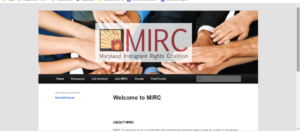 there is huge emphasis on the banner and organization inside. The banner alone takes up majority of the space from above the fold leaving the audience to scroll down to see more information. If one were to find more information on who exactly is apart of the MIRC they would have to go to the navigation bar, select “Join MIRC”
there is huge emphasis on the banner and organization inside. The banner alone takes up majority of the space from above the fold leaving the audience to scroll down to see more information. If one were to find more information on who exactly is apart of the MIRC they would have to go to the navigation bar, select “Join MIRC” 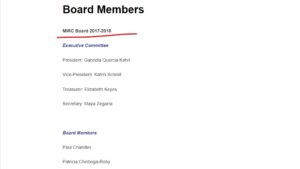 and then choose “Board Members”. After browsing this particular page one finds all the potential authors. The problem with this is it only dates the 2017-2018 board so stating these members as the authors is not necessarily reliable.
and then choose “Board Members”. After browsing this particular page one finds all the potential authors. The problem with this is it only dates the 2017-2018 board so stating these members as the authors is not necessarily reliable.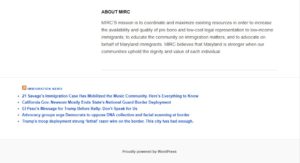 audience. Because one knows the organization wants to provide immigrants with resources from reading the about section the primary audience would be immigrants. Right below the about MIRC section is the immigrant news which can be a tool used to keep up with new updates regarding immigration. This particular section is very close to the footer and beneath the main focus point of the page so one could identify that secondary audience are those who may support the cause.
audience. Because one knows the organization wants to provide immigrants with resources from reading the about section the primary audience would be immigrants. Right below the about MIRC section is the immigrant news which can be a tool used to keep up with new updates regarding immigration. This particular section is very close to the footer and beneath the main focus point of the page so one could identify that secondary audience are those who may support the cause.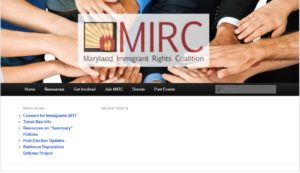 By selecting the resources page those who have immigrant status can find extra information. However this page just provides a link to
By selecting the resources page those who have immigrant status can find extra information. However this page just provides a link to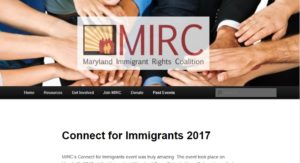 resources instead of listing the resources as soon as the page is accessed. This is another indicator that the primary audience is those of immigrant status because it is the first tab next to the homepage indicating the level of importance. Next on the navigation bar is the “Get Involved” page. Within this
resources instead of listing the resources as soon as the page is accessed. This is another indicator that the primary audience is those of immigrant status because it is the first tab next to the homepage indicating the level of importance. Next on the navigation bar is the “Get Involved” page. Within this 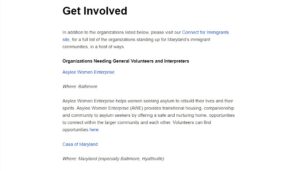 page there are just lists of other organizations that one may volunteer at if they would like to help immigrants this is also an indicator of their secondary audience. After the “Join MIRC” page on the navigation menu there is the “Donate” page. This page states once again the mission of MIRC. From knowing their mi
page there are just lists of other organizations that one may volunteer at if they would like to help immigrants this is also an indicator of their secondary audience. After the “Join MIRC” page on the navigation menu there is the “Donate” page. This page states once again the mission of MIRC. From knowing their mi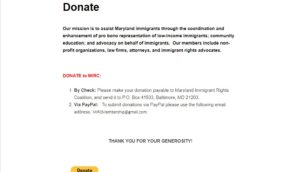 ssion and the nature of donation pages one can infer that the genre of this website is non-profit. The last page on the navigation bar is the “Past Events” page. Within this page the reader is able to see all the previous events MIRC has hosted in the 2017-2018 year. This
ssion and the nature of donation pages one can infer that the genre of this website is non-profit. The last page on the navigation bar is the “Past Events” page. Within this page the reader is able to see all the previous events MIRC has hosted in the 2017-2018 year. This 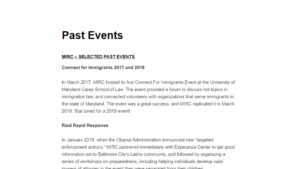 is the second time the website has mentioned this particular time frame meaning one can infer from the context the last time the whole website was updated was the 2017-2018 year.
is the second time the website has mentioned this particular time frame meaning one can infer from the context the last time the whole website was updated was the 2017-2018 year.